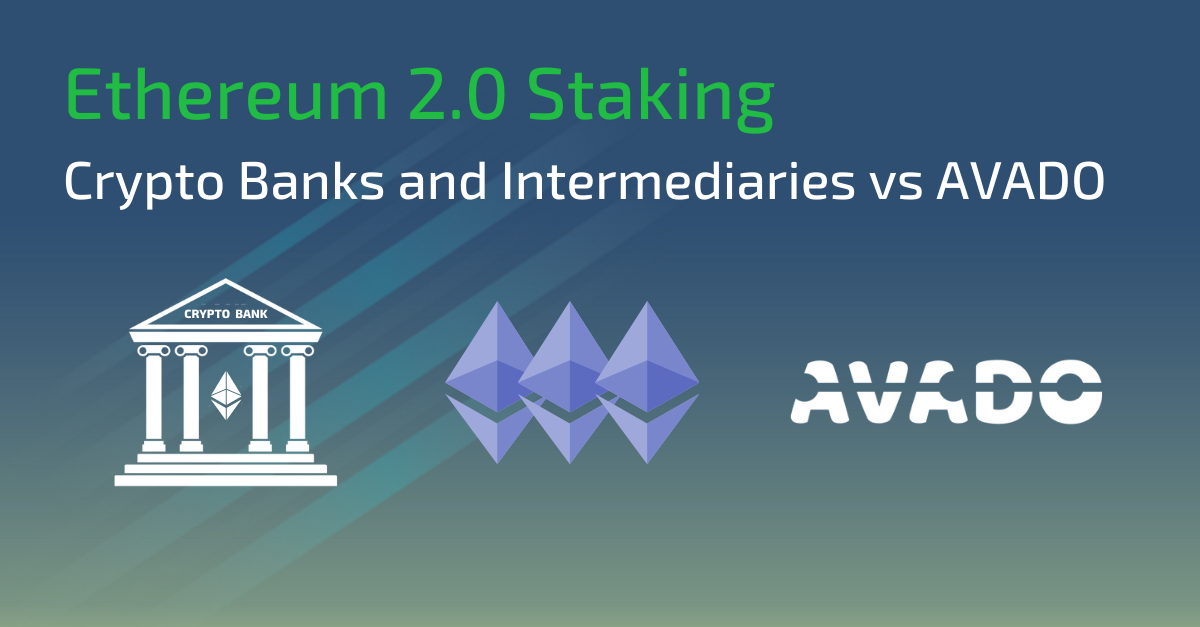
July 20, 2021
Staking ETH 2.0 through a crypto intermediary or bank vs. on AVADO
Staking ETH 2.0 through a crypto intermediary or bank vs. on AVADO
May 24 · 8 min read

As the industry continues its long-awaited transition from Proof of Work to Proof of Stake, staking is emerging as an important point of focus. Retail investors are becoming financially savvy and are looking for opportunities to earn additional income on the crypto they hodl.
Staking your crypto is one of such opportunities. It allows you to earn passive income, benefit from the asset capital appreciation while also contributing to the network’s decentralization and security.
Depending on the network and the size of your capital, the yield from staking can far outpace other means of passive income. And that’s the beauty of it; it’s mostly unattended time and requires little to no work.
The entry barrier for staking varies, but there are many cryptocurrencies to choose from when staking.
The question then is, how and where do you stake your cryptocurrency?
Today we are comparing two types of staking. The first one will be staking on a 3rd party platform or through an intermediary, such as a crypto bank.
This method is usually simpler to execute and has lower entry barriers, but as we’ll see, this convenience comes at a cost.
The second method we look at is running your own validator node on an AVADO device and staking independently. While requiring a bit more knowledge and a small investment, this method offers greater rewards and higher security.
Staking through an intermediary or a crypto bank
Excluding cryptocurrency exchanges, the options for highly reputable 3rd party staking are scarce. Most banks worldwide have not yet adapted to the emerging field of crypto and DeFi, and as a result, you will not find them offering these services.
There are only a handful of licensed crypto banks globally, and most of them are based in Switzerland ( SEBA , Sygnum ). Interestingly enough, those two banks don’t offer staking as a service to their clients.
On the other hand, Bitcoin Suisse , the well-known Swiss crypto broker, started offering staking services to its clients with the launch of ETH 2.0.
Bitcoin Suisse charges its clients a flat 15% fee taken from the ETH staking rewards. The exact lockup period is currently unknown, as it’s dependent on when Ethereum 2.0 fully launches, which is expected to be in 1 to 3 years.
Apart from banks, staking can be done through certain collective pools such as Rocketpool or Guarda pool . Such staking pools require a lot of trust in the people behind them and the underlying smart contracts, and as such, they might not appeal to everyone.
The main selling point of staking through a crypto bank is convenience. You’re not required to be particularly knowledgeable about blockchain technology, and all the technical details are taken care of.
As you’re dealing with a regulated financial institution, you are protected by law from certain types of risk associated with delegating your crypto.
Pros
- No downtime risk
In this situation, the actual staking is being done by the intermediary. They undertake the arduous process of keeping a node running 24/7 to not face the risk associated with slashed funds because of node downtime.
2. No upfront cost
While not as steep as Proof of Work, staking still has some hardware requirements. A decent to a good computer is at least needed to keep the validator node running smoothly. But since you’re not the one doing the staking, you don’t have to acquire hardware and meet the technical requirement yourself.
3. 32 ETH isn’t required to start staking
Probably the most significant barrier faced by those who want to start staking Ethereum 2.0 is to have 32 ETH. At the time of writing 32 ETH is roughly equivalent to $112,000, which isn’t realistic for many. Pooling your ETH with a bank or a collective pool allows you to benefit from staking even with smaller capital.
4. Using your staked funds
Some crypto financial service providers or banks offer additional functionality based on your staked assets. For example, Bitcoin Suisse offers loans with staked ETH as collateral. If you are issued a minted token representing your staked ETH, you may be allowed to trade that token depending on the platform.
Despite the benefits of staking with crypto banks, one must pay attention to the risks and disadvantages.
Cons
- Not your keys, not your coins
We are all familiar with this age-old crypto adage. It’s right up there with the whole HODL thing. At the end of the day, no one likes giving up custody of their hard-earned crypto. Even though you are partially isolated from some of the risks in a regulated crypto bank, most people would avoid doing this if possible.
2. Huge fees
The industry seems to have settled at 15% as the staking fee. This is the percentage of your staking rewards that you have to give up to the intermediary for convenience. It may not seem like a lot at first, but if you calculate the cost over a longer period and consider the potential price increase of the token, the fees can mount up to a significant sum.
3. True delegation for Ethereum doesn’t exist
Unlike many other Proof of Stake blockchains, Ethereum has no support for true delegation. You can not stake from a wallet securely by delegating; therefore, any “delegation staking” is done by giving up your coins to an actual validator.
4. Extra risk
You are faced with many risks in the crypto world. And by letting someone else stake your assets, you are exposed to more of those risks. Be it legal risk, smart contract risk, or the risk of hacks, your risk exposure is quite high with this staking method.
Staking on AVADO
The alternative to staking through an intermediary is running your own validator node. This task will require more of your time and resources but comes with greater benefits.
Most users have turned away from running a validator node because of the technical proficiency and know-how required. It is precisely this hurdle that AVADO eliminates.
The AVADO devices come with a pre-installed Operating System that is built for running your own nodes. It is incredibly user-friendly, turning the convoluted and often too complicated process of starting your own node into a breeze.
No centralization, no fees that reduce your profits, and no added risk from giving up custody. After the initial investment into the device, you will be enjoying all the benefits of doing your own staking with almost none of the downside of other methods.
Pros
- Your keys, your coins
The benefits here are clear. Anyone who has experienced issues with a centralized entity holding your crypto is familiar with the pains and fear associated with outages and not being able to withdraw or manage your assets. By keeping custody, you ensure this will never happen to you.
2. No fees
Another clear win. You keep 100% of the rewards from staking and ensure maximum growth of your assets.
3. One Time investment, different use
So far, we’ve focused on Ethereum 2.0 staking, but AVADO supports a host of other blockchains. In addition to staking Ethereum 2.0, you can stake Avalanche and soon also on HOPR. In other words, your initial investment in acquiring an AVADO can bring you value in multiple ways.
4. No expertise required
Traditionally, setting up a full node is intimidating. A lot of technical knowledge is required, and this is a major hurdle for most people. AVADO solves this problem with its custom-built, user-friendly interface that enables you to start a full node with a few clicks. Not only that, when the time comes for a network upgrade, the AVADO team takes care of it, and the upgrade is automatically applied.
5. The DappStore
An additional feature of the AVADO devices is the DappStore . It contains decentralized applications that offer financial incentives to its users in exchange for running the DApp. Onboarding and updating them is easy and automated.
6. Contributing to decentralization and the growth of blockchain networks
The importance of this last point is directly proportional to your own belief in the blockchain industry. Decentralization is at the core of blockchain technology and crypto. It is required for a healthy future of the technology. Running your own staking node is directly tied to this goal and helps the network to become more secure.
AVADO provides the most convenient solution for crypto investors to set up a validator node at home and stake their own coins. There are also downsides which one should not ignore.
Cons
- Upfront cost
You have to purchase an AVADO device, so there is an upfront cost. But the obvious benefit lies in the extra profit you will earn by not paying fees to third-party staking service providers. You can expect to break even in the first 1–3 months.
2. Requires 32 ETH
With how the Ethereum Proof of Stake protocol is designed, validators need a minimum of 32 ETH to start staking. As of the time of writing, this comes out to a substantial amount of capital. If you own an AVADO device and want to start a node at home, you need a minimum of 32 ETH to begin staking.
3. Consistency
While not being active work, being a validator requires consistency. You are taking on the obligation of consistently maintaining a live node. That means you need a very stable internet connection and power source, and you bear the risk of penalties in the form of decreased balance of your ETH in the event of downtime. While these penalties are usually very minor for a minor amount of downtime, they should still be noted by potential Validators.
Conclusion
If a person is willing to stake and has at least 32 ETH, then staking on an AVADO device is an obvious choice.
At the current price, staking 32 ETH at 7% APY yields around $8,000 per year, or $667 a month. With that in mind, you can cover the cost of the device in the first one to three months.
Afterward, you will enjoy the full benefits of staking. Staking on Ethereum 2.0 is an undertaking of at least one to three years; if you decide to stake on Ethereum 2.0, buying your AVADO device will save you a large amount of rewards that would have otherwise been paid to crypto banks.
We at AVADO have a reputable team that is continuously working on improving the user experience.
Aside from the features we’ve discussed so far, there’s a lot more in the pipeline, such as regular updates and support for many more blockchains and staking.
AVADO is a plug-and-play blockchain computer. Running a blockchain node on AVADO is the easiest way to participate in decentralized networks that reward you with crypto. ⛓️ ⬛
You get access through its WiFi hotspot or VPN. 🌐 💻
The user-friendly UI allows you to use and manage the device from anywhere in the world. 🌎
It comes pre-installed with the AVADO OS, saving you a lot of time and research setting up a node. ⌛
Using an AVADO is convenient, secure and true to the spirit of decentralization. 🙌🏻
Get your AVADO at www.ava.do/shop or join our Telegram group https://t.me/joinchat/F_LlkBLEoDrFioPNviEpsQ
